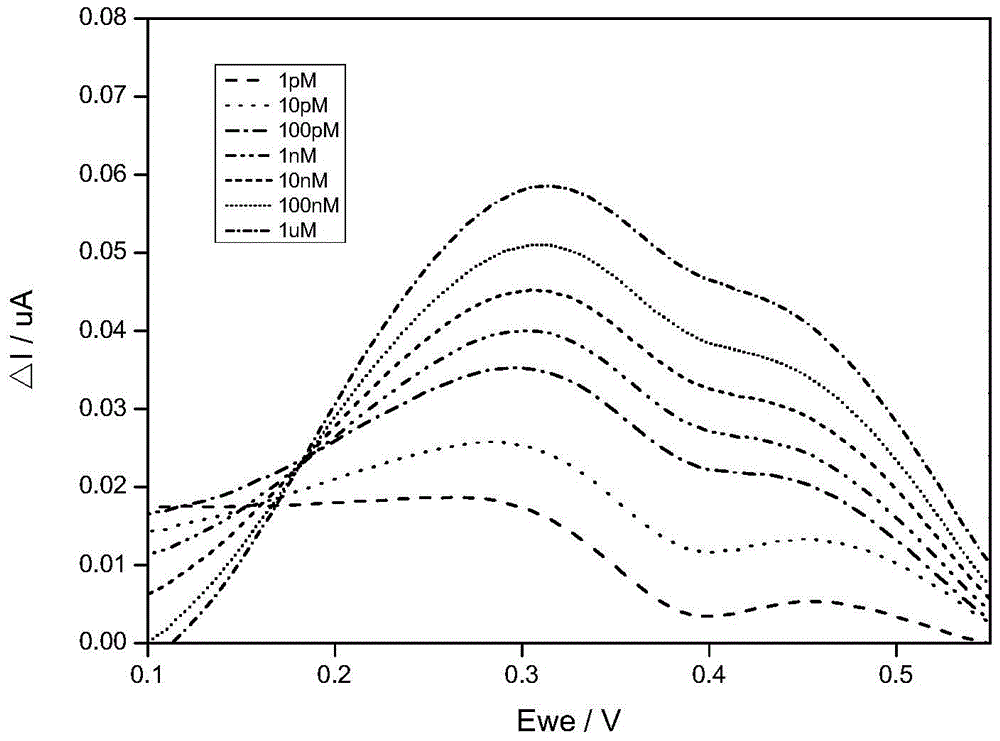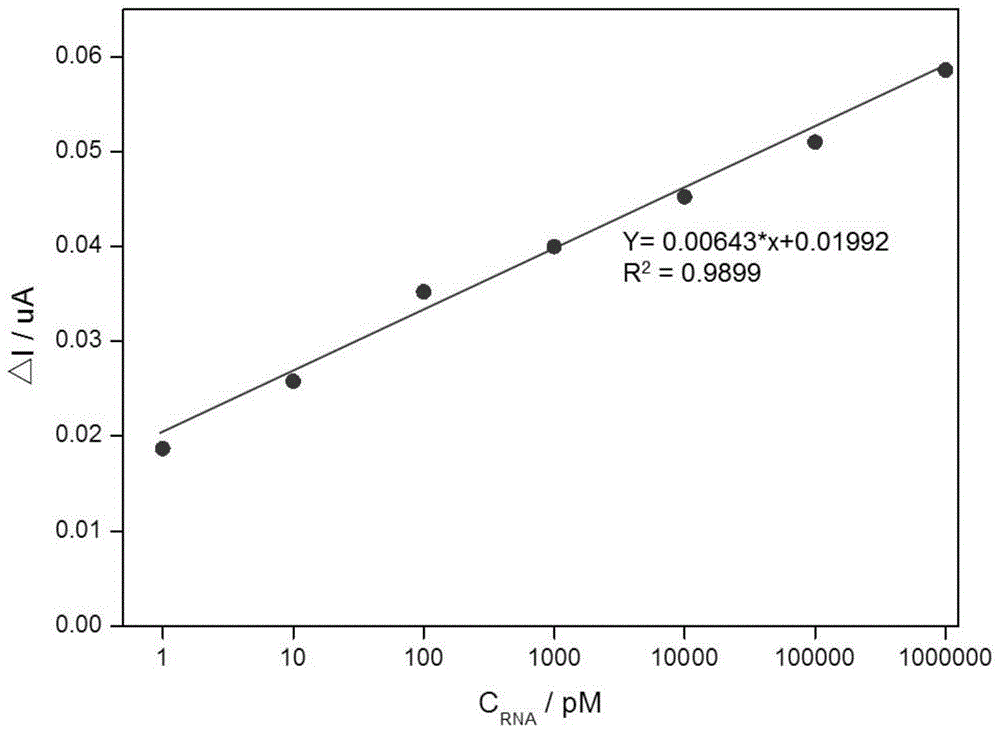Electrochemical sensor based on stem-loop structure probe and preparation method thereof
A stem-loop structure, electrochemical technology, applied in the direction of material electrochemical variables, etc., can solve the problems of reaction condition interference, sensor accuracy, sensitivity and application range limitations, to achieve low-cost detection, improve sample utilization, and improve hybridization efficiency effect
- Summary
- Abstract
- Description
- Claims
- Application Information
AI Technical Summary
Problems solved by technology
Method used
Image
Examples
Embodiment 1
[0050] Reagents include:
[0051] 4 pieces of single-stranded DNA for self-assembly to form DNA probes, A (93bp, molecular weight 28496.0, 5'-end modified ferrocene ssDNA), B (55bp, molecular weight 17018.0, 5'-end modified sulfhydryl ssDNA), C (55bp , molecular weight 16898.0, 5'end modified sulfhydryl ssDNA), D (55bp, molecular weight 16877.0, 5'end modified thiol ssDNA). The four single-stranded DNAs that constitute the tetrahedral structure contain three structural domains, each of which is complementary to the corresponding domains of the other three single-stranded DNAs (17 base pairs). A forms a stem-loop structure at the 5' end, the stem structure is 6 base pairs, and the loop structure is 22 bases for the recognition of target molecules.
[0052] A (SEQ ID NO: 1):
[0053] 5'-Fc-TCCAGCGTTCAACATCAGTCTGATAAGCTAACGCTGTTACATTCCTAAGTCTGAAACATTACAGCTTGCTACACGAGAAGAGCCGCCATAGTA-3'
[0054] B (SEQ ID NO: 2):
[0055] 5'-HS-C6-TATCACCAGGCAGTTGACAGTGTAGCAAGCTGTAATAGATGCGAGG...
Embodiment 2-6
[0078] Reagents include:
[0079] The A chain and target microRNAs change according to the type of early screening cancer, see the table below for details.
[0080]
[0081]
[0082] The detection steps are the same as in Example 1.
Embodiment 7
[0084] Reagent is with embodiment 1.
[0085] Detection steps 1-4 are the same as in Example 1.
[0086] In the fifth step, the target microRNA: hsa-miR-21 was diluted with cell lysate to a concentration of 1 μM. The working electrode was placed in the reaction system to hybridize with the target microRNA for 15 minutes. After fast complementary pairing, the electrodes were taken out, rinsed with PBS buffer solution, and placed in PBS for differential pulse scanning. The electrochemical detection uses CHI electrochemical analyzer (CHI660) and adopts the traditional three-electrode system, the platinum plate electrode is the counter electrode, and the Ag / AgCl electrode is the reference electrode. The scanning voltage range is 0~0.6V, and the pulse period is 0.5s. Detect the relationship between the concentration of the target molecule hsa-miR-21 in the actual simulated sample and the detection signal, the results are as follows image 3 shown.
[0087] By detecting microRN...
PUM
| Property | Measurement | Unit |
|---|---|---|
| Diameter | aaaaa | aaaaa |
Abstract
Description
Claims
Application Information
 Login to View More
Login to View More - R&D
- Intellectual Property
- Life Sciences
- Materials
- Tech Scout
- Unparalleled Data Quality
- Higher Quality Content
- 60% Fewer Hallucinations
Browse by: Latest US Patents, China's latest patents, Technical Efficacy Thesaurus, Application Domain, Technology Topic, Popular Technical Reports.
© 2025 PatSnap. All rights reserved.Legal|Privacy policy|Modern Slavery Act Transparency Statement|Sitemap|About US| Contact US: help@patsnap.com



